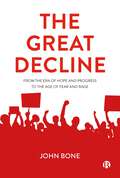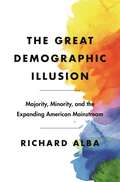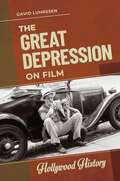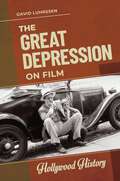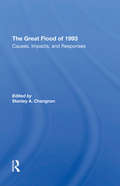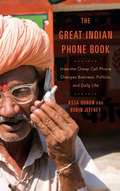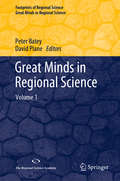- Table View
- List View
Great Days at Work: How Positive Psychology can Transform Your Working Life
by Suzanne HazeltonGreat Days at Work will enable you to become more enthusiastic at work, feel more positive and work more effectively with others. Drawing on the latest insights from positive psychology, and based on hard business results, it outlines the practical day-to-day changes you can make immediately for instant benefit, as well as helping you develop a longer term strategy that means you'll get more out of work. This easily applicable book reveals how to develop an effective perspective on time, embed productive new habits, gain a clear sense of self and build better working relationships. As a result you will make a bigger contribution to your organization, as well as feel more engaged, satisfied and in control of your own work and career. Discover how to have a great day at work, every day!
The Great Decline: From the Era of Hope and Progress to the Age of Fear and Rage
by John BoneIt seems clear that many formerly stable societies in wealthy developed countries appear to be falling into an apparent state of ‘permacrisis' accompanied by an increasingly angry and irrational social and political culture that is undermining the peace and stability of our societies and democratic institutions, from the local to the global. Applying an original biosocial approach (the social map), and drawing on ideas and evidence from sociology, history and political economy, to psychology, neuroscience and epigenetics, John Bone argues that conditions in our turbocapitalist and increasingly estranged, media dominated societies have created a toxic environment, deeply damaging to our mental and physical health. As well as shedding new light on our current troubles, Bone also outlines why this leaves us ill prepared to deal with two of the greatest challenges confronting humanity: the rise of AI and automation and how we deal with climate change.
The Great Decline: From the Era of Hope and Progress to the Age of Fear and Rage
by John BoneIt seems clear that many formerly stable societies in wealthy developed countries appear to be falling into an apparent state of ‘permacrisis' accompanied by an increasingly angry and irrational social and political culture that is undermining the peace and stability of our societies and democratic institutions, from the local to the global. Applying an original biosocial approach (the social map), and drawing on ideas and evidence from sociology, history and political economy, to psychology, neuroscience and epigenetics, John Bone argues that conditions in our turbocapitalist and increasingly estranged, media dominated societies have created a toxic environment, deeply damaging to our mental and physical health. As well as shedding new light on our current troubles, Bone also outlines why this leaves us ill prepared to deal with two of the greatest challenges confronting humanity: the rise of AI and automation and how we deal with climate change.
The Great Demographic Illusion: Majority, Minority, and the Expanding American Mainstream
by Richard AlbaWhy the number of young Americans from mixed families is surging and what this means for the country’s future Americans are under the spell of a distorted and polarizing story about their country’s future―the majority-minority narrative―which contends that inevitable demographic changes will create a society with a majority made up of minorities for the first time in the United States’s history. The Great Demographic Illusion reveals that this narrative obscures a more transformative development: the rising numbers of young Americans from ethno-racially mixed families, consisting of one white and one nonwhite parent. Examining the unprecedented significance of mixed parentage in the twenty-first-century United States, Richard Alba looks at how young Americans with this background will play pivotal roles in the country’s demographic future.Assembling a vast body of evidence, Alba explores where individuals of mixed parentage fit in American society. Most participate in and reshape the mainstream, as seen in their high levels of integration into social milieus that were previously white dominated. Yet, racism is evident in the very different experiences of individuals with black-white heritage. Alba’s portrait squares in key ways with the history of immigrant-group assimilation, and indicates that, once again, mainstream American society is expanding and becoming more inclusive.Nevertheless, there are also major limitations to mainstream expansion today, especially in its more modest magnitude and selective nature, which hinder the participation of black Americans and some other people of color. Alba calls for social policies to further open up the mainstream by correcting the restrictions imposed by intensifying economic inequality, shape-shifting racism, and the impaired legal status of many immigrant families.Countering rigid demographic beliefs and predictions, The Great Demographic Illusion offers a new way of understanding American society and its coming transformation.
The Great Depression on Film (Hollywood History)
by David LuhrssenThis book presents the Great Depression through the lens of 13 films, beginning with movies made during the Depression and ending with films from the 21st century, and encourages readers to examine the various depictions of this period throughout history.The Great Depression on Film is a unique guide to how the Great Depression was represented and is remembered, making it an excellent resource for students or anyone interested in film history or U.S. history. Each film is set in a different sector of American life, focusing on such topics as white supremacy, political protest, segregation, environmental degradation, crime, religion, the class system, and popular culture in the U.S. during the 1930s.This book is indispensable for clearing away misconceptions fostered by the movies while acknowledging the power of film in shaping public memory. The book separates fact from fiction, detailing where the movies are accurate and where they depart from reality, and places them in the larger context of historical and social events. Eyewitness or journalistic accounts are referenced and quoted in the text to help readers differentiate between ideas, attitudes, and events presented in the films, as well as the historical facts which inspired those films.
The Great Depression on Film (Hollywood History)
by David LuhrssenThis book presents the Great Depression through the lens of 13 films, beginning with movies made during the Depression and ending with films from the 21st century, and encourages readers to examine the various depictions of this period throughout history.The Great Depression on Film is a unique guide to how the Great Depression was represented and is remembered, making it an excellent resource for students or anyone interested in film history or U.S. history. Each film is set in a different sector of American life, focusing on such topics as white supremacy, political protest, segregation, environmental degradation, crime, religion, the class system, and popular culture in the U.S. during the 1930s.This book is indispensable for clearing away misconceptions fostered by the movies while acknowledging the power of film in shaping public memory. The book separates fact from fiction, detailing where the movies are accurate and where they depart from reality, and places them in the larger context of historical and social events. Eyewitness or journalistic accounts are referenced and quoted in the text to help readers differentiate between ideas, attitudes, and events presented in the films, as well as the historical facts which inspired those films.
The Great Disruption: How the Climate Crisis Will Transform the Global Economy
by Paul GildingIt's time to stop just worrying about climate change, says Paul Gilding. Instead we need to brace for impact, because global crisis is no longer avoidable. The 'Great Disruption' started in 2008, with spiking food and oil prices and dramatic ecological change like the melting polar icecap. It is not simply about fossil fuels and carbon footprints. We have come to the end of Economic Growth, Version 1.0, a world economy based on consumption and waste, where we lived beyond the means of our planet's ecosystems and resources. The Great Disruption offers a stark and unflinching look at the challenge humanity faces - yet also a deeply optimistic message. The coming decades will see loss, suffering and conflict as our planetary overdraft is paid. However, they will also bring out the best humanity can offer: compassion, innovation, resilience and adaptability. Gilding tells us how to fight, and win, what he calls 'the One Degree War' to prevent catastrophic warming of the earth, and how to start today. The crisis we are in represents a rare chance to replace our addiction to growth with an ethic of sustainability, and it's already happening. It's also an unmatched business opportunity: old industries will collapse while new companies literally reshape our economy. In the aftermath of the Great Disruption, we will measure 'growth' in a new way. It will mean not quantity of stuff, but quality, and happiness, of life. And, yes, there is life after shopping. The Great Disruption is an invigorating and well-informed polemic by an advocate for sustainability and climate change who has dedicated his life to campaigning for a balanced use of Earth's limited resources. It is essential reading.
The Great Disruptor: Über Trump, die Medien und die Politik der Herabsetzung
by Lars Koch Tobias Nanz Christina RogersDer Sturm auf das Kapitol bildet den Höhepunkt einer populistischen Konfrontations- und Mobilisierungsstrategie, die darauf ausgelegt war, Zustimmung durch eine Politik der Herab- und Feindsetzung zu akkumulieren. In der aktualisierten, 2. Auflage geht es weiterhin darum, aus kultur- und medienwissenschaftlicher Perspektive das öffentliche Auftreten von Donald Trump zu untersuchen und zu zeigen, wie der 45. US-Präsident an der gesellschaftlichen Konfrontation unterschiedlicher politischer Gruppen partizipierte, diese kommunikativ weiter eskalierte und von der sich immer radikaler gestaltenden Polarisierung politisch zu profitieren hoffte. Allerdings weitet sich der Untersuchungsfokus und nimmt nunmehr auch die beiden letzten Jahre seiner Amtszeit mit in den Blick, in denen Trump durch immer schrillere Töne im Kontext von Black Live Matters und der Corona-Krise, durch die Anheizung von Verschwörungstheorien und durch radikale Diskreditierung von politischen Verfahren und Institutionen die US-amerikanische Gesellschaft bis an den Rand eines Bürgerkriegs getrieben hat. Diskutiert werden Trumps Mediengebrauch, seine mit Herabsetzungen, Beleidigungen und Unterstellungen arbeitenden Adressierungsstrategien und seine Politik der Affekte. Die Beiträge des Bandes rücken den „great disruptor“ in ein Spannungsfeld von Populärkultur, fragmentierter Öffentlichkeit und rhetorischer Feindsetzung.
The Great Divide: Unequal Societies And What We Can Do About Them
by Joseph StiglitzWhy has inequality increased in the Western world - and what can we do about it? In The Great Divide, Joseph E. Stiglitz expands on the diagnosis he offered in his best-selling book The Price of Inequality and suggests ways to counter this growing problem. With his characteristic blend of clarity and passion, Stiglitz argues that inequality is a choice - the cumulative result of unjust policies and misguided priorities.In these essays, articles and reflections, Stiglitz fully exposes the inequality - from its dimensions and its causes to its consequences for the world - that is afflicting America and other Western countries in thrall to neoliberalism. From Reagan-era policies to the Great Recession and its long aftermath, Stiglitz delves into the processes and irresponsible policies - deregulation, tax cuts for the rich, the corruption of the political process - that are leaving many people further and further behind and turning the dream of a socially mobile society into an ever more unachievable myth. With formidable yet accessible economic insight, he urges us to embrace real solutions: increasing taxes on corporations and the wealthy; investing in education, science, and infrastructure; helping homeowners instead of banks; and, most importantly, doing more to restore the economy to full employment. Stiglitz's analysis reaches beyond America - the inequality leader of the developed world - to draw lessons from Scandinavia, Singapore, and Japan, and he argues against the tide of unnecessary, destructive austerity that is sweeping across Europe.Ultimately, Stiglitz believes our choice is not between growth and fairness; with the right policies, we can choose both.
Great Expectations: The Social Sciences in Great Britain
by Commission on the Social SciencesThe social sciences in the United Kingdom are extensive, diverse and influential. At any one time, more than four million students study the social sciences in schools; and about a half million students study social science in universities. Total university income from the social sciences is at the four billion dollar level. Beyond that, many social scientists hold key positions in government, business, the media, civil service, and the voluntary sector. Great Expectations reviews the status of the social sciences in Great Britain at the beginning of the twenty-first century. While making clear that work opportunities for social scientists are substantial and that levels of intellectual performance equal that of graduates in physics, it provides a hard hitting, empirically grounded examination of a near crisis situation. The report goes far beyond what one conventionally expects in commissioned reports, arguing that the academic treadmill, driven by excessive accountability burdens, reduces the originality and quality of much academic research. The report emphasizes the ideological and parochial nature of much British social research. As a result, there is little applicability internationally, even less interdisciplinary work, and at times, an outright bias against the market economy as such. The Commission Report, is even handed, tough minded, and frank in discussing how it is that social science and new social and technical forces do not always mesh. The optimism exuded is measured, but genuine. Great Expectations offers policy recommendations and scientific goals that can be serviceable not only in the United Kingdom, but in all advanced societies in which social research is a central component of economic stability and development. It is a superb reference volume enriched by original analysis and pungent, clear-headed writing. Members of the commission include: Professor David Rhind, Vice Chancellor of the City University served as Chairman of the Commission. Members included Huw Beynon (Cardiff), Patricia Broadbent (Bristol), Vicki Bruce (Edinburgh), Barry Buzzan (LSE), Sue Duncan (Government Researcher), Stuart Etherington (National Council for Voluntary Organizations), Janet Lewis (Oxford), Denise Lievesley (UNESCO), Richard Portes (LBS), Marc Renaud (Research Council of Canada), Michael Tonry (Cambridge), and David Walker (The Guardian).
Great Expectations: The Social Sciences in Great Britain
by Commission on the Social SciencesThe social sciences in the United Kingdom are extensive, diverse and influential. At any one time, more than four million students study the social sciences in schools; and about a half million students study social science in universities. Total university income from the social sciences is at the four billion dollar level. Beyond that, many social scientists hold key positions in government, business, the media, civil service, and the voluntary sector. Great Expectations reviews the status of the social sciences in Great Britain at the beginning of the twenty-first century. While making clear that work opportunities for social scientists are substantial and that levels of intellectual performance equal that of graduates in physics, it provides a hard hitting, empirically grounded examination of a near crisis situation. The report goes far beyond what one conventionally expects in commissioned reports, arguing that the academic treadmill, driven by excessive accountability burdens, reduces the originality and quality of much academic research. The report emphasizes the ideological and parochial nature of much British social research. As a result, there is little applicability internationally, even less interdisciplinary work, and at times, an outright bias against the market economy as such. The Commission Report, is even handed, tough minded, and frank in discussing how it is that social science and new social and technical forces do not always mesh. The optimism exuded is measured, but genuine. Great Expectations offers policy recommendations and scientific goals that can be serviceable not only in the United Kingdom, but in all advanced societies in which social research is a central component of economic stability and development. It is a superb reference volume enriched by original analysis and pungent, clear-headed writing. Members of the commission include: Professor David Rhind, Vice Chancellor of the City University served as Chairman of the Commission. Members included Huw Beynon (Cardiff), Patricia Broadbent (Bristol), Vicki Bruce (Edinburgh), Barry Buzzan (LSE), Sue Duncan (Government Researcher), Stuart Etherington (National Council for Voluntary Organizations), Janet Lewis (Oxford), Denise Lievesley (UNESCO), Richard Portes (LBS), Marc Renaud (Research Council of Canada), Michael Tonry (Cambridge), and David Walker (The Guardian).
Great Expectations: The Sociology of Survival and Success in Organized Team Sports
by Christopher B. DoobIn Great Expectations: The Sociology of Survival and Success in Organized Team Sports, sociological analysis proves to be a powerful ally for grasping how the sports world unfolds for team players, providing a range of sociological ideas and concepts that extend throughout the book. The text boxes and class discussion sections help summarize key issues, linking important sociological concepts to the topics at hand. The eight chapters begin with an introduction and then detail athletes’ activities at different stages in their development.
Great Expectations: The Sociology of Survival and Success in Organized Team Sports
by Christopher B. DoobIn Great Expectations: The Sociology of Survival and Success in Organized Team Sports, sociological analysis proves to be a powerful ally for grasping how the sports world unfolds for team players, providing a range of sociological ideas and concepts that extend throughout the book. The text boxes and class discussion sections help summarize key issues, linking important sociological concepts to the topics at hand. The eight chapters begin with an introduction and then detail athletes’ activities at different stages in their development.
Great Flicks: Scientific Studies of Cinematic Creativity and Aesthetics
by Dr. Dean Keith SimontonWhat does it take to make a great motion picture? What do we even mean by cinematic greatness? What is more important: movie awards, critical acclaim, or box office success? Who has the biggest impact: the writer, the director, or the actors? Scientific research has provided some provocative answers. This review of cinematic creativity and aesthetics is confined to scientific studies carried out by a multidisciplinary group of researchers. Do great films receive both shiny trophies and five stars? Chapter 2 concentrates on movie awards, including the Oscars and Golden Globes, and how those awards relate to critical acclaim. How do the dramatic awards compare with the visual, technical, and music awards? Chapter 3 studies more closely how these awards cluster together and which of these clusters best predict cinematic success. How does box office compare with critical evaluations and movie awards? Chapter 4 adds a new consideration, namely the film's financial performance. The following four chapters focus on specific contributions to a film's impact: Chapter 5 covers the script (including writers), Chapter 6 the director (or "auteur"), Chapter 7 the actors (especially gender differences), and Chapter 8 the music (both scores and songs). Chapter 9 addresses the question of whether the same cinematic factors that make some films great also make other films bad: Are bombs the exact opposite of masterpieces? The book closes with an epilogue on future directions in scientific studies of cinematic creativity and aesthetics. What do researchers need to do if we want a complete understanding of what it takes to create a powerful cinematic experience? This volume will be invaluable to anyone interested in film, including any aficionado who is open to a scientific approach, and researchers in the areas of creativity, aesthetics, and cultural economics. The reported research comes from many disciplines, including psychology, sociology, economics, management, marketing, communications, journalism, broadcasting, history, musicology, and statistics.
Great Flicks: Scientific Studies of Cinematic Creativity and Aesthetics
by Dr. Dean Keith SimontonWhat does it take to make a great motion picture? What do we even mean by cinematic greatness? What is more important: movie awards, critical acclaim, or box office success? Who has the biggest impact: the writer, the director, or the actors? Scientific research has provided some provocative answers. This review of cinematic creativity and aesthetics is confined to scientific studies carried out by a multidisciplinary group of researchers. Do great films receive both shiny trophies and five stars? Chapter 2 concentrates on movie awards, including the Oscars and Golden Globes, and how those awards relate to critical acclaim. How do the dramatic awards compare with the visual, technical, and music awards? Chapter 3 studies more closely how these awards cluster together and which of these clusters best predict cinematic success. How does box office compare with critical evaluations and movie awards? Chapter 4 adds a new consideration, namely the film's financial performance. The following four chapters focus on specific contributions to a film's impact: Chapter 5 covers the script (including writers), Chapter 6 the director (or "auteur"), Chapter 7 the actors (especially gender differences), and Chapter 8 the music (both scores and songs). Chapter 9 addresses the question of whether the same cinematic factors that make some films great also make other films bad: Are bombs the exact opposite of masterpieces? The book closes with an epilogue on future directions in scientific studies of cinematic creativity and aesthetics. What do researchers need to do if we want a complete understanding of what it takes to create a powerful cinematic experience? This volume will be invaluable to anyone interested in film, including any aficionado who is open to a scientific approach, and researchers in the areas of creativity, aesthetics, and cultural economics. The reported research comes from many disciplines, including psychology, sociology, economics, management, marketing, communications, journalism, broadcasting, history, musicology, and statistics.
The Great Flood Of 1993: Causes, Impacts, And Responses
by Stanley ChangnonThe flood that affected a third of the United States during the summer of 1993 was the nation's worst, ranking as a once-in-300-years event. It severely tested national, state, and local systems for managing natural resources and for handling emergencies, illuminating both the strengths and weaknesses in existing methods of preparing for and dealing with massive prolonged flooding. Through detailed case studies, this volume diagnoses the social and economic impacts of the disaster, assessing how resource managers, flood forecasters, public institutions, the private sector, and millions of volunteers responded to it. The first comprehensive evaluation of the 1993 flood, this book examines the way in which floods are forecast and monitored, the effectiveness of existing recovery processes, and how the nation manages its floodplains. The volume concludes with recommendations for the future, in hope of better preparing the country for the next flood or other comparable disaster.
The Great Flood Of 1993: Causes, Impacts, And Responses
by Stanley ChangnonThe flood that affected a third of the United States during the summer of 1993 was the nation's worst, ranking as a once-in-300-years event. It severely tested national, state, and local systems for managing natural resources and for handling emergencies, illuminating both the strengths and weaknesses in existing methods of preparing for and dealing with massive prolonged flooding. Through detailed case studies, this volume diagnoses the social and economic impacts of the disaster, assessing how resource managers, flood forecasters, public institutions, the private sector, and millions of volunteers responded to it. The first comprehensive evaluation of the 1993 flood, this book examines the way in which floods are forecast and monitored, the effectiveness of existing recovery processes, and how the nation manages its floodplains. The volume concludes with recommendations for the future, in hope of better preparing the country for the next flood or other comparable disaster.
The Great Good Place: Cafes, Coffee Shops, Bookstores, Bars, Hair Salons, and Other Hangouts at the Heart of a Community
by Ray OldenburgThe landmark survey that celebrates all the places where people hang out--and is helping to spawn their revivalA New York Times Book Review Editor's Choice"Third places," or "great good places," are the many public places where people can gather, put aside the concerns of home and work (their first and second places), and hang out simply for the pleasures of good company and lively conversation. They are the heart of a community's social vitality and the grassroots of a democracy. Author Ray Oldenburg portrays, probes, and promotes th4ese great good places--coffee houses, cafes, bookstores, hair salons, bars, bistros, and many others both past and present--and offers a vision for their revitalization.Eloquent and visionary, this is a compelling argument for these settings of informal public life as essential for the health both of our communities and ourselves. And its message is being heard: Today, entrepreneurs from Seattle to Florida are heeding the call of The Great Good Place--opening coffee houses, bookstores, community centers, bars, and other establishments and proudly acknowledging their indebtedness to this book.
The Great Good Place: Cafes, Coffee Shops, Bookstores, Bars, Hair Salons, and Other Hangouts at the Heart of a Community
by Ray OldenburgThe landmark survey that celebrates all the places where people hang out--and is helping to spawn their revivalA New York Times Book Review Editor's Choice"Third places," or "great good places," are the many public places where people can gather, put aside the concerns of home and work (their first and second places), and hang out simply for the pleasures of good company and lively conversation. They are the heart of a community's social vitality and the grassroots of a democracy. Author Ray Oldenburg portrays, probes, and promotes th4ese great good places--coffee houses, cafes, bookstores, hair salons, bars, bistros, and many others both past and present--and offers a vision for their revitalization.Eloquent and visionary, this is a compelling argument for these settings of informal public life as essential for the health both of our communities and ourselves. And its message is being heard: Today, entrepreneurs from Seattle to Florida are heeding the call of The Great Good Place--opening coffee houses, bookstores, community centers, bars, and other establishments and proudly acknowledging their indebtedness to this book.
The Great Indian Phone Book: How The Cheap Cell Phone Changes Business, Politics, And Daily Life
by Assa DoronOver just a decade in India, the mobile phone was transformed from a rare, unwieldy instrument to a palm-sized staple that even poor fisherman can afford. Assa Doron and Robin Jeffrey investigate the social revolution ignited by what may be the most significant communications device in history and explore the whole ecosystem of cheap mobile phones.
The Great Indian Phone Book: How The Cheap Cell Phone Changes Business, Politics, And Daily Life
by Assa DoronOver just a decade in India, the mobile phone was transformed from a rare, unwieldy instrument to a palm-sized staple that even poor fisherman can afford. Assa Doron and Robin Jeffrey investigate the social revolution ignited by what may be the most significant communications device in history and explore the whole ecosystem of cheap mobile phones.
The Great Inequality (Critical Interventions)
by Michael D YatesA growing inequality in income and wealth marks modern capitalism, and it negatively affects nearly every aspect of our lives, especially those of the working class. It is and will continue to be the central issue of politics in almost every nation on earth. In this book, the author explains inequality in clear, passionate, and intelligent prose: what it is, why it matters, how it affects us, what its underlying causes are, and what we might do about it. This book was written to encourage informed radical action by working people, the unemployed, and the poor, uniquely blending the author’s own experiences with his ability to make complex issues comprehensible to a mass audience. This book will be excellent for courses in a variety of disciplines, and it will be useful to activists and the general reading public.
The Great Inequality (Critical Interventions)
by Michael D YatesA growing inequality in income and wealth marks modern capitalism, and it negatively affects nearly every aspect of our lives, especially those of the working class. It is and will continue to be the central issue of politics in almost every nation on earth. In this book, the author explains inequality in clear, passionate, and intelligent prose: what it is, why it matters, how it affects us, what its underlying causes are, and what we might do about it. This book was written to encourage informed radical action by working people, the unemployed, and the poor, uniquely blending the author’s own experiences with his ability to make complex issues comprehensible to a mass audience. This book will be excellent for courses in a variety of disciplines, and it will be useful to activists and the general reading public.
Great Minds in Regional Science: Volume 1 (Footprints of Regional Science)
by Peter Batey David PlaneThis is the first volume in a new series on 'Great Minds in Regional Science,' which seeks to present a contemporary view on the scientific relevance of the work done by great thinkers in regional science. It presents, among others, Walter Isard, Martin Beckmann and Gunnar Myrdal. Each contribution combines factual biographical information, a description of their major contributions, and a discussion of the broader context of the work, as well as an assessment of its current relevance, scientific recognition and policy impact. The book attempts to fill a gap in our knowledge, and to respond to the growing interest in the formation and development of the field of regional science and its key influential figures.
The Great Mindshift: How a New Economic Paradigm and Sustainability Transformations go Hand in Hand (The Anthropocene: Politik—Economics—Society—Science #2)
by Maja GöpelThis book describes the path ahead. It combines system transformation researchwith political economy and change leadership insights when discussing the needfor a great mindshift in how human wellbeing, economic prosperity and healthyecosystems are understood if the Great Transformations ahead are to lead to moresustainability. It shows that history is made by purposefully acting humans andintroduces transformative literacy as a key skill in leading the radical incremental change

